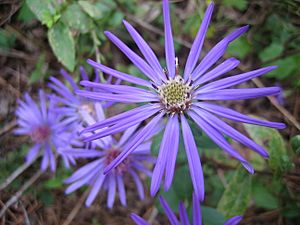Symphyotrichum georgianum facts for kids
Quick facts for kids Symphyotrichum georgianum |
|
|---|---|
 |
|
| Conservation status | |
| Scientific classification | |
| Synonyms | |
|
The Georgia aster, scientifically known as Symphyotrichum georgianum, is a beautiful and rare flowering plant. It belongs to the aster family, which includes many daisy-like flowers. This special plant grows naturally in the southeastern parts of the United States. You can find it in states like Alabama, Georgia, North Carolina, and South Carolina. Sadly, it might have disappeared from Florida.
Contents
What Does It Look Like?
The Georgia aster is a strong plant that grows from underground stems called rhizomes. These rhizomes help it spread and form groups of woody stems. These stems can grow up to 100 centimeters (about 39 inches) tall.
Its leaves are thick and dark green. They can be up to 7 centimeters (about 2.8 inches) long and 2 centimeters (about 0.8 inches) wide. The leaves are shaped like an oval or a spear, and their edges can be smooth or slightly jagged.
The plant's flowers grow in heads on hairy stems. Each flower head is quite large, about 5 to 6 centimeters (2 to 2.4 inches) across. The outer petals, called ray florets, are purple and can be dark purple, lavender, or reddish-purple. The small flowers in the center, called disc florets, are white and purplish.
When Does It Bloom?
This lovely plant blooms later in the year, usually in October and November.
Where Does It Grow?
The Georgia aster likes to grow in woodlands where oak and pine trees are common. Long ago, this area was a type of grassland called a savanna with post oak trees. The Georgia aster was an important part of this natural area.
This kind of plant community needs natural events like wildfires to stay healthy. Fires help clear out old plants and make space for new ones. Today, much of this natural habitat has been damaged or destroyed. This is because fires are often stopped, and large grazing animals are no longer around.
Because of these changes, the Georgia aster is now a relict species. This means it's a leftover from a past ecosystem. It now grows only in the few remaining woodlands that are similar to its original home.
Why Is It Rare?
Scientists believe there are about 146 groups of Georgia asters left. The main reason it's rare is that its natural habitat is disappearing. Stopping natural fires, which the plant needs, is a big problem.
Other things that threaten the Georgia aster include building new roads. Also, using herbicides (chemicals that kill plants) can harm it.
Gallery
See also
 In Spanish: Aster de Georgia para niños
In Spanish: Aster de Georgia para niños




